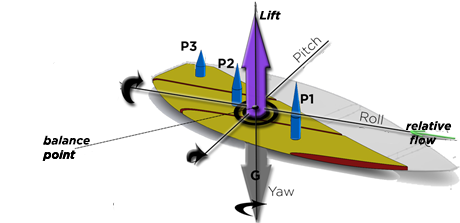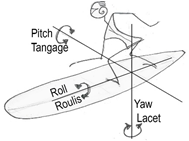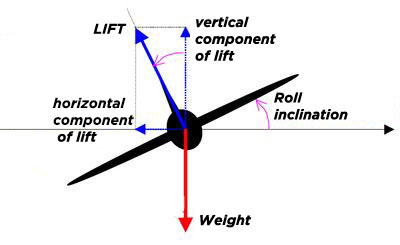
In surf culture intuition is a concept linked to the art of shaping. What is counter-intuitive then settles as an accepted idea without control or scientific validation process. The rocker curve is often described as generating the turn, and this seems so intuitive that it is an often accepted fact. But the physics of planing shows us that this is not the case. The vision of a rail that will print a curved trajectory in the flow when the surfer turns, is a fine example of intuition induced by our visual experience, but without physical foundation. If that were the case it would be impossible to turn with a board without a rocker! and yet a board without rocker turns...

Ryan Burch 2009 surfboard ratio 0.5 Lindsay Lord Planning Hull (Kenvin, s.d.)

The Rolll rotation immerses the rail and produces the turn by laterally projecting a planing lift component. given roll. Maneuverability depends on how easy it is to vary the roll angle, so low roll torque means high maneuverability, and high roll torque means low maneuverability.
The surf turn is the variation of the direction of the trajectory vector, be careful not to confuse turn, and rotation around the yaw axis:

A surfer on a board without a fin can perfectly have a straight trajectory (no turns) and do a 360 degree around the yaw axis! the board will then go through a series of drift angles defined as the angle between the trajectory and the longitudinal axis of the board. See drift surf angle variation.
The planing turn is fully understood and mastered in aeronautics, we will draw the basic theoretical elements from it, the surfer will easily find his bearings there.
TRAJECTORY DEVIATION INDUCED BY ROLL INCLINATION:
The roll inclination curves the trajectory of the board, because when planing our board behaves like an airplane:

When the plane tilts, the horizontal component of lift changes the direction of the plane. The trajectory then becomes a curve whose radius varies according to the inclination. If the bank generates a horizontal component of lift equal to the centrifugal force, the turn is balanced and the pilot could stand in the axis of the lift without feeling unbalanced. The surfer carving in the bottom-turn is a close example of this situation, the effects of rails, as well as the forces on the fins also play their part in the reaction of the board, but let's ignore them for the moment. In this case of planing with tilt, the surfer instinctively adjusts the roll to generate a tilt maintaining balance, he only has to follow the "plumb line" of his inner ear, to apply the perfect tilt, too instinctively that you lean into corners on your bike. If the centrifugal force is greater than the horizontal component, it means that the board inclination is insufficient or the radius of the turn is too tight, the surfer will be ejected from the turn and this is the fall. If the inclination is too great, the surfer's support on the board will not be balanced by the centrifugal force and the surfer will fall on the inside of the turn. The condition of this equilibrium is simply formulated by balancing the centrifugal force and the horizontal component of lift:
Equation 62: centrifugal force(N)=M*V²/R
with M mass of the surfer + board in Kg, V trajectory speed in m/sec and R radius of the turn in meters.
Considering that M *9.81 = vertical lift in Newtons,
Equation 63: Horizontal component of lift(N)=tg(inclination)*M*g
g = 9.81 m/s²
The radius of the curve balancing the centrifugal force is therefore :
Equation 64: R=V² / (tg(inclination)*9.81)
Let's watch our surfer turn. Let's look at the angle of incidence which combines with the roll. Let's observe the mass of water ejected in reaction to the horizontal projection of the lift which deflects the board producing the curve, let us sharpen our intuition on this cornerstone of the physics of planing.
